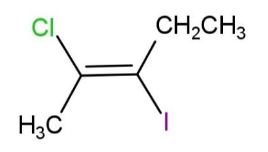
Answer
403.5k+ views
Hint:IUPAC is the international union for pure and applied chemistry. It has made certain rules for the naming of organic compounds. Cis and trans are known as two different isomers of the same compound, they are position isomers.
Complete step-by-step answer:The naming of organic compounds is done by following the norms and standards given by IUPAC. According to IUPAC, some of the nomenclature rules followed in compounds with double or triple bonds, and functional groups, are:
-the longest possible carbon chain is selected for naming that contains functional groups and maximum multiple bonds.
- numbering is done in a way that functional groups get the lowest possible numbers, followed by multiple bonds.
- two or more similar groups are given the prefix, di, tri, tetra, etc.
- among more than two functional groups, one is taken as principal group while others as substituent groups.
- when unsaturated compounds contain atoms on the same adjacent carbon, then it is called as cis, while when on the opposite side, it is called trans.
We are given a compound that has chlorine and iodine as functional groups. We will number the longest chain. Starting from the methyl group, and ending on the ethyl group, we will number them 1, 2, 3, 4, 5 carbons. Carbon-2 and 3 appear with a double bond. Since the functional groups are on opposite sides, it will be named as trans.
So, the name will be trans-2-chloro-3-iodo-2-pentene. Hence, option A is correct.
Note:The parent hydrocarbon chain consists of 5 carbons, with a double bond at carbon-2, so it is named as 2-pentene. For, naming a continuous carbon chain is selected, so this chain cannot start from the carbon having Cl, or I atoms.
Complete step-by-step answer:The naming of organic compounds is done by following the norms and standards given by IUPAC. According to IUPAC, some of the nomenclature rules followed in compounds with double or triple bonds, and functional groups, are:
-the longest possible carbon chain is selected for naming that contains functional groups and maximum multiple bonds.
- numbering is done in a way that functional groups get the lowest possible numbers, followed by multiple bonds.
- two or more similar groups are given the prefix, di, tri, tetra, etc.
- among more than two functional groups, one is taken as principal group while others as substituent groups.
- when unsaturated compounds contain atoms on the same adjacent carbon, then it is called as cis, while when on the opposite side, it is called trans.
We are given a compound that has chlorine and iodine as functional groups. We will number the longest chain. Starting from the methyl group, and ending on the ethyl group, we will number them 1, 2, 3, 4, 5 carbons. Carbon-2 and 3 appear with a double bond. Since the functional groups are on opposite sides, it will be named as trans.
So, the name will be trans-2-chloro-3-iodo-2-pentene. Hence, option A is correct.
Note:The parent hydrocarbon chain consists of 5 carbons, with a double bond at carbon-2, so it is named as 2-pentene. For, naming a continuous carbon chain is selected, so this chain cannot start from the carbon having Cl, or I atoms.
Recently Updated Pages
Identify the feminine gender noun from the given sentence class 10 english CBSE

Your club organized a blood donation camp in your city class 10 english CBSE

Choose the correct meaning of the idiomphrase from class 10 english CBSE

Identify the neuter gender noun from the given sentence class 10 english CBSE

Choose the word which best expresses the meaning of class 10 english CBSE

Choose the word which is closest to the opposite in class 10 english CBSE

Trending doubts
How do you graph the function fx 4x class 9 maths CBSE

Fill the blanks with the suitable prepositions 1 The class 9 english CBSE

Which are the Top 10 Largest Countries of the World?

A rainbow has circular shape because A The earth is class 11 physics CBSE

Change the following sentences into negative and interrogative class 10 english CBSE

The Equation xxx + 2 is Satisfied when x is Equal to Class 10 Maths

Give 10 examples for herbs , shrubs , climbers , creepers

Difference between Prokaryotic cell and Eukaryotic class 11 biology CBSE

One Metric ton is equal to kg A 10000 B 1000 C 100 class 11 physics CBSE





